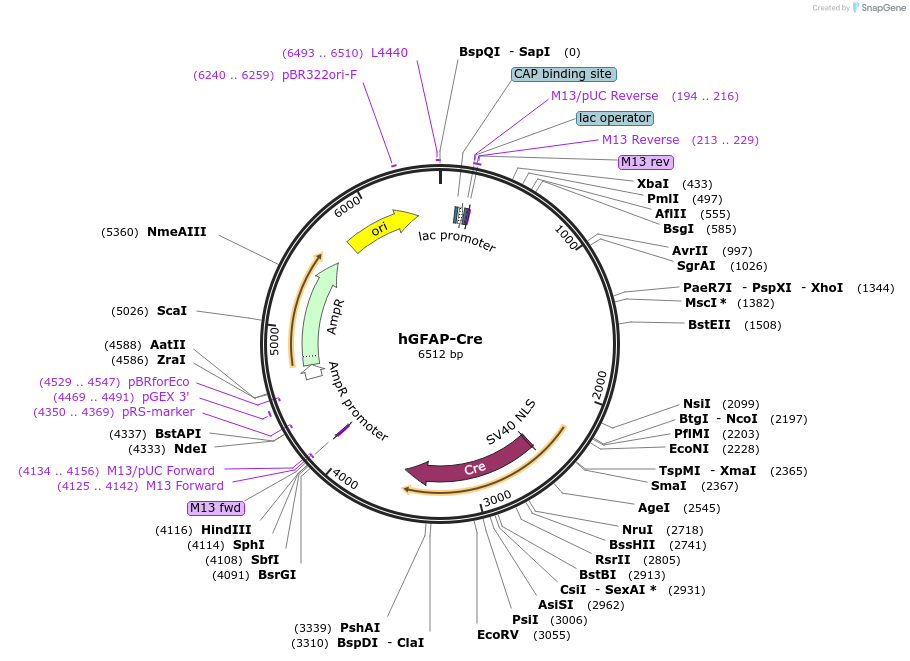-
PurposeMouse astrocyte expression of Cre
-
Depositing Lab
-
Publication
-
Sequence Information
Ordering
| Item | Catalog # | Description | Quantity | Price (USD) | |
|---|---|---|---|---|---|
| Plasmid | 40591 | Standard format: Plasmid sent in bacteria as agar stab | 1 | $85 | |
Backbone
-
Vector backbonepgfa2-lac2
-
Backbone manufacturerMichael Brenner (PMID: 7952266)
- Backbone size w/o insert (bp) 5500
- Total vector size (bp) 6600
-
Modifications to backboneLacZ coding region of pgfa2-lac2 replaced by a nuclear-targeted Cre coding sequence.
-
Vector typeMammalian Expression, Mouse Targeting, Cre/Lox
Growth in Bacteria
-
Bacterial Resistance(s)Ampicillin, 100 μg/mL
-
Growth Temperature37°C
-
Growth Strain(s)DH5alpha
-
Copy numberHigh Copy
Gene/Insert
-
Gene/Insert nameCre recombinase
-
Alt nameCreNLS
-
Alt namehGFAP-Promoter-Cre-MP-1
-
Alt nameTg95
-
SpeciesH. sapiens (human), M. musculus (mouse); Phage
-
Insert Size (bp)1100
-
MutationConstruct contains a nuclear-targeted Cre recombinase followed by a heterologous mouse intron and polyadenylation signal, all under the control of the gfa2 promoter
-
Entrez GeneGFAP (a.k.a. ALXDRD)
- Promoter hGFAP promoter
-
Tags
/ Fusion Proteins
- NLS (N terminal on insert)
- MP-1 fragment (mouse protamine 1 intron and polyadenylation signal) (C terminal on backbone)
Cloning Information
- Cloning method Restriction Enzyme
- 5′ cloning site SalI (destroyed during cloning)
- 3′ cloning site MluI (destroyed during cloning)
- 5′ sequencing primer GFAPpro-F (5'-ACTCCTTCATAAAGCCCTCG-3') (Common Sequencing Primers)
Resource Information
-
A portion of this plasmid was derived from a plasmid made byDr. Brenner, Drs. Raul Torres and Klaus Rajewsky
-
Articles Citing this Plasmid
Terms and Licenses
-
Academic/Nonprofit Terms
-
Industry Terms
- Not Available to Industry
Trademarks:
- Zeocin® is an InvivoGen trademark.
Depositor Comments
This plasmid encodes a transgene to express the Cre recombinase in astrocytes of transgenic mice. A DNA fragment encoding the Cre recombinase was inserted into an expression cassette containing the gfa2 promoter (Besnard et al., 1991), a 2.2-kb 5' flanking region from the human GFAP (hGFAP) gene. The nuclear targeting signal from the SV40 large T antigen was inserted at the amino terminal end of the coding region, because it reportedly increases the efficiency of DNA excision by the recombinase (Gu et al., 1993). A heterologous intron and polyadenylation signal were provided by sequences from the mouse protamine 1 gene at the 3' end.
The hGFAP-cre transgene was constructed by excising the lacZ coding region from pgfa2-lac2 (Brenner et al., 1994) by BamHI digestion, and replacing it by blunt end ligation with a nuclear-targeted Cre coding sequence. The latter was obtained as a 1.1-kb SalI-MluI fragment from plasmid pTZ19RCreNLS, which was kindly provided by Drs. Raul Torres and Klaus Rajewsky. Both junctions were verified by DNA sequencing.
These plasmids were created by your colleagues. Please acknowledge the Principal Investigator, cite the article in which the plasmids were described, and include Addgene in the Materials and Methods of your future publications.
-
For your Materials & Methods section:
hGFAP-Cre was a gift from Albee Messing (Addgene plasmid # 40591 ; http://n2t.net/addgene:40591 ; RRID:Addgene_40591) -
For your References section:
hGFAP-cre transgenic mice for manipulation of glial and neuronal function in vivo. Zhuo L, Theis M, Alvarez-Maya I, Brenner M, Willecke K, Messing A. Genesis. 2001 Oct;31(2):85-94. 10.1002/gene.10008 PubMed 11668683









